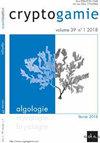Silica-Scaled Chrysophytes in Large Tributaries of Lake Baikal
IF 1.5
4区 生物学
Q3 MARINE & FRESHWATER BIOLOGY
引用次数: 14
Abstract
Abstract High diversity of silica-scaled chrysophytes was recorded in the Barguzin River mouth and the Selenga River delta. Their flora was represented by 66 species and intra-specific taxa: Chrysosphaerella — 2, Paraphysomonas — 8, Clathromonas — 5, Spiniferomonas — 8, Mallomonas — 29, and Synura — 14. Eight taxa of silica-scaled chrysophytes were observed for the first time in Russia: Chrysosphaerella rotundata, Mallomonas doignonii, M. trummensis, M. corymbosa, Clathromonas poteriophora, Paraphysomonas acuminata acuminata, P. vulgaris, and Synura laticarina. In May, we found scales of Mallomonas striata with morphologically changed structure in the mouth of the Barguzin River and Srednyaya Channel of the Selenga River delta. The flora of silica-scaled chrysophytes studied differs from one tributary to another. We observed only 52 species in the Selenga River delta, whereas in the Barguzin River mouth we identified 35 species. These large rivers affect the flora of Lake Baikal diversifying silica-scaled chrysophytes in its southern and central basins. The total list of species and intra-specific taxa in the Selenga River delta, Barguzin River mouth, and in Lake Baikal includes 72 taxa. Therefore, this area may be considered as a “hotspot” of silica-scaled chrysophytes together with three hotspots observed worldwide earlier.贝加尔湖大支流中的硅鳞苔藓
巴尔古津河口和色楞嘎河三角洲记录了高多样性的硅鳞苔藓。共有66个种和种内分类群:Chrysosphaerella - 2、Paraphysomonas - 8、Clathromonas - 5、Spiniferomonas - 8、Mallomonas - 29和Synura - 14。在俄罗斯首次观察到8个硅鳞虫分类群:圆形金单胞菌(Chrysosphaerella rotundata)、doignonii绿单胞菌(malomonas doignonii)、trummensis、corymbosa、poteriophora绿单胞菌(Clathromonas poteriophora)、尖锐副葡萄单胞菌(paraphysomata acuminata)、P. vulgaris和Synura laticarina。5月,在色楞格河三角洲巴尔古津河口和斯瑞德尼亚亚海峡发现了形态结构发生变化的纹状绿单胞菌鳞片。所研究的硅鳞菊的植物区系因支流而异。在色楞格河三角洲我们只发现了52种,而在巴尔古津河口我们发现了35种。这些大河影响了贝加尔湖的植物区系,使其南部和中部盆地的硅鳞菊藻多样化。色楞嘎河三角洲、巴尔古津河口和贝加尔湖的种内分类群共72个。因此,该地区与较早在世界范围内观察到的三个热点地区一起,可被认为是硅鳞苔藓的“热点”。
本文章由计算机程序翻译,如有差异,请以英文原文为准。
求助全文
约1分钟内获得全文
求助全文
来源期刊

Cryptogamie Algologie
生物-海洋与淡水生物学
CiteScore
2.60
自引率
7.70%
发文量
11
审稿时长
>12 weeks
期刊介绍:
Cryptogamie is a fast-track and peer-reviewed journal of international scope publishing in English only. It accepts original papers and review articles on the taxonomy, biology and ecology of all cryptogams. An issue of Cryptogamie may be devoted to a single topic, under the responsibility of guest editor(s). All articles published in Cryptogamie are compliant with the different nomenclatural codes. A copyright assignment will be signed by the authors before publication.
Cryptogamie, Algologie accepts articles on systematics as well as ecology and evolution of any kind of algae (including Cyanobacteria).
 求助内容:
求助内容: 应助结果提醒方式:
应助结果提醒方式:


